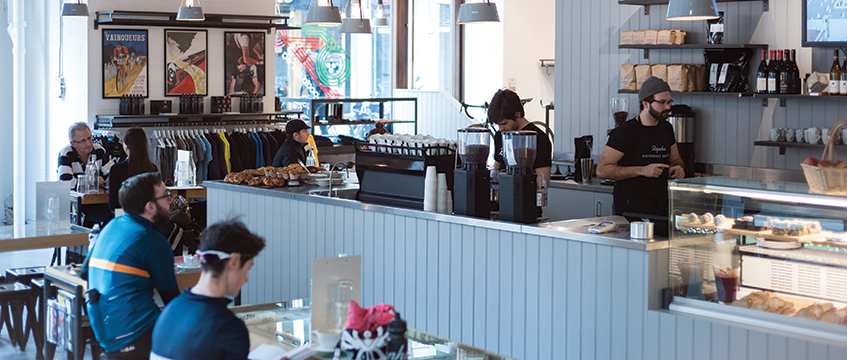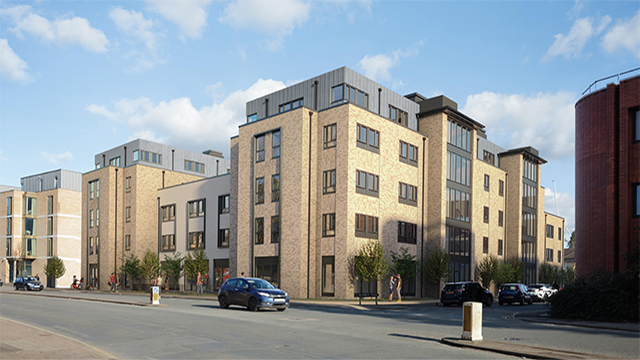The metamorphosis of bricks and mortar retail spaces
Step inside Rapha’s Soho store and you get a glimpse of how blended retail can transform a shopping experience.
Since opening in 2012, the cycling brand’s Brewer Street Clubhouse has become more than a place to shop, but a destination for London’s cycling community.
At any one time, between 40% and 100% of Rapha’s floorspace is taken up with alternative uses, including its café, a starting point for rides, talks and workshops. Eight metres of wall space is also set aside for non-retail use, providing visitors with racks on which to hang up their bikes.
Step inside Rapha’s Soho store and you get a glimpse of how blended retail can transform a shopping experience.
Since opening in 2012, the cycling brand’s Brewer Street Clubhouse has become more than a place to shop, but a destination for London’s cycling community.
At any one time, between 40% and 100% of Rapha’s floorspace is taken up with alternative uses, including its café, a starting point for rides, talks and workshops. Eight metres of wall space is also set aside for non-retail use, providing visitors with racks on which to hang up their bikes.
Rapha retail manager Adam Hockley says: “Rapha is all about bringing people together for the love of road cycling. The store has to reflect how they spend their time. It is about creating hotspots of experience and making customers feel at home.”
He adds: “It’s a model people in property can find hard to understand, but every one of our 18 clubhouses are profitable. In the omni-channel world it is hard to measure the impact of what we are doing, but we believe it is the right thing for our brand and eventually the KPIs will come along to prove it.”
The difficulty of quantifying the value of non-core retail space is a major challenge. Yet many brands are replacing racks of product with alternative uses, although few retailers are taking the concept as far as Rapha.
Creative space
Department stores have been curating hybrid spaces for years. M&S is positioning its F&B offer at the heart of its stores.
Next has worked with numerous café operators to create a more compelling offer and H&M’s new fashion brand ARKET will incorporate a café within its new Regent Street store.
Revo chief executive Ed Cooke says: “For physical retail to compete with and complement the online offer, it needs to create spaces that appeal to the senses, compelling people to visit and engage with the brand.”
And brand engagement is critical and often overrides the traditional view of the store as a purely transactional space.
Fashion retailer Carhartt Work in Progress has just started integrating F&B within its retail stores, allocating around one-third of space at its King’s Cross Boulevard unit to a coffee bar.
Carhartt retail manager Marvin Javier says: “We had to open the store at 9am, a time of day when nobody is out buying clothes. We looked at alternative draws and coffee seemed a good fit. You have got to offer a point of difference and an environment that promotes greater brand awareness.”
He adds: “We want people to enjoy and explore our space. It is not about maximising densities and cramming in a load of stock, but creating environments that people remember.”
And the trend has moved beyond cafés. From Hackett’s integration of barbers, to athleisure retailers such as Lululemon offering complimentary in-store yoga classes; the hybrid retail/leisure model continues to evolve.
Recent projects for Jeff Kindleysides, owner of retail design agency Checkland Kindleysides, include the design of Jigsaw’s new 2,500 sq ft store in King’s Cross which recently hosted a show for London Fashion Week.
He says: “Brands want their physical stores to be as energetic as their digital spaces. They are there to entice and delight.”
And that drive isn’t limited to London. “There are plenty of regional retailers blending their offer,” says Nick Hilton, partner at national agent Workman Retail. “From national retailers to independents, a growing number of occupiers are looking at hybrid models.”
Regional examples include the announcement that Gino D’Acampo is opening a prosecco bar and restaurant inside the Kingswood Next store in Hull. In York, John Lewis has set aside space for regional restaurant Filmore & Union, and at Manchester Fort Shopping Park, Mothercare incorporates a dedicated play area and café.
Yet creating effective hybrid environments is not without its challenges. “You have got to understand it is about integrating complementary offers, not random bolt-ons,” warns Yulia Rorstrom, founder of blow dry bar operator Duck & Dry.
Duck & Dry has three salons across London. When Rorstrom opened the flagship store on King’s Road she set aside a chunk of floorspace for a prosecco bar and events lounge.
Although this focus on creating a destination has paid dividends for Duck & Dry, which is now being invited to take space in other stores (see below), it has not been easy.
[caption id="attachment_893625" align="aligncenter" width="847"] Duck & Dry[/caption]
Rorstrom warns: “You can get carried away thinking of new ways of using space, from art exhibitions to fashion pop-ups, but it has got to be aligned with your brand.
“These things are time-consuming, expensive to implement and are rarely a revenue stream in their own right. You should do it because it is core to your business model, not just because it is on-trend.”
South American-inspired fashion retailer Blaiz has also experimented with blended space while operating a pop-up on the King’s Road, installing an açai juice bar.
Founder Stephanie Margaronis insists the offer has helped differentiate the brand but warns: “It has its challenges, from assigning space to allocating staff and dealing with health and safety.”
Yet in the quest to promote more experiential retail destinations, the blending offers is here to stay. Not only is the new hybridisation of space popular with retailers, but landlords recognise the benefits as they try to differentiate their schemes.
“We are very keen to encourage tenants to blend,” says Hannah Grievson, commercial property manager at Blaiz and Duck & Dry’s landlord, Sloane Stanley. “It is not enough to just sell products now.”
Argent’s Craig White is project manager at King’s Cross retail destination Coal Drops Yard. He says: “Pretty much every letting we are doing is hybrid in some form or another, whether it is retailers incorporating cafés or merging with art galleries. Everything has to become a lot more flexible to support them.”
The challenge is not only around providing floorplates flexible enough for different uses, but rental structures and leases which allow for a more fluid use of space.
Neil Barber, leasing director at Cain International, is in discussions with occupiers looking to blend their offer within the developer’s £400m mixed-use Islington Square development.
He says: “In the past, retail landlords have wanted to control tenants with tight user clauses, but you have to work with your occupiers to help them flourish. Landlords have to adapt to support retailers in creating appealing destinations.”
Sweaty Betty flags down the right mix
Women’s activewear retailer Sweaty Betty has blended all its brand components into the delivery of its new store at 1 Carnaby Street. Opened on 7 September, the three-floor flagship combines fashion, fitness, food and beauty.
Some 19 years after the Sweaty Betty brand was launched, the retailer has chosen to use its physical space to reflect the diversity of its offer. The new 3,500 sq ft store incorporates ground-floor retail, a fitness studio, Duck & Dry blow-dry bar and Farm Girl café.
“It reflects everything Sweaty Betty represents in a single store,” says retail director Emma Thornton. “It’s about more than shopping, but wellness and lifestyle.”
The Sweaty Betty store opens from 7.30am-7.30pm, allowing customers to combine shopping with exercise and leisure as part of the same brand experience.
“It drives footfall, offers customers an amazing experience and encourages them to stay in the store longer,” says Thornton.
She insists that the hybrid draw has ensured the ground floor retail is “super dense and profitable” and that bringing in handpicked partner brands “makes absolute economic sense.”
She adds: “It has taken a lot of attention to detail to get the mix right. It is ensuring everyone shares the common goal of offering a great customer experience that is the secret to a successful blended offer.”
Claire Robson











